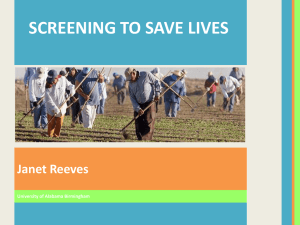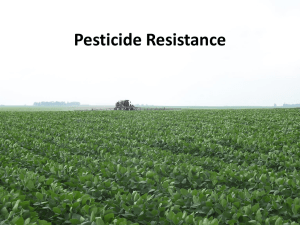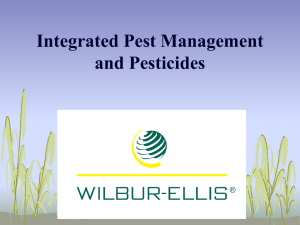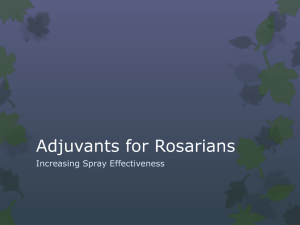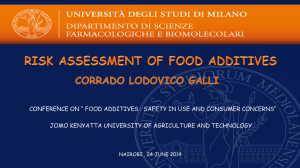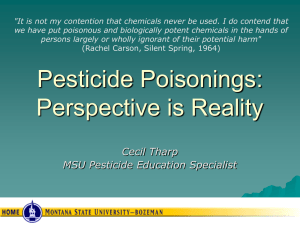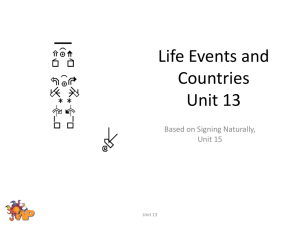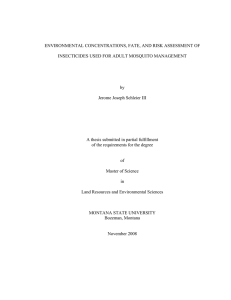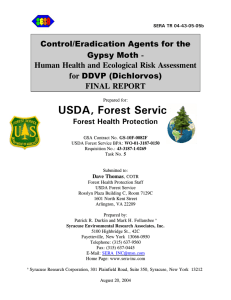Assessing Effects of Mosquito Control Pesticides
advertisement
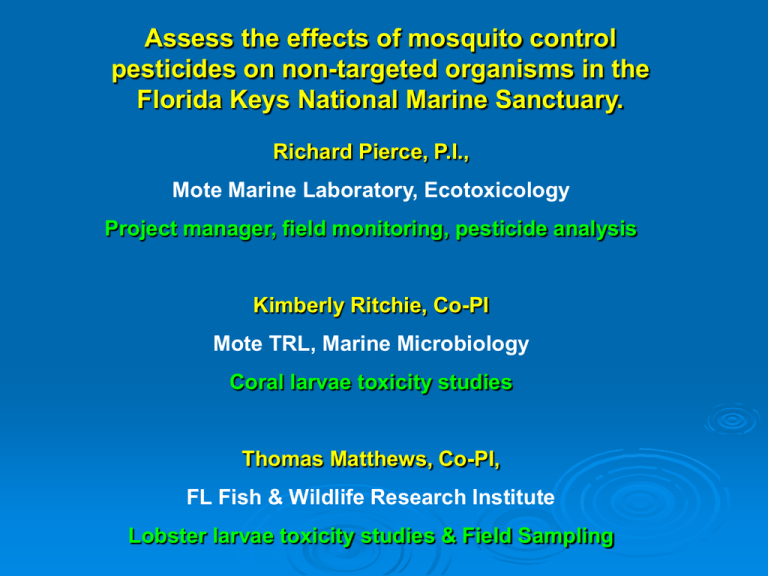
Assess the effects of mosquito control pesticides on non-targeted organisms in the Florida Keys National Marine Sanctuary. Richard Pierce, P.I., Mote Marine Laboratory, Ecotoxicology Project manager, field monitoring, pesticide analysis Kimberly Ritchie, Co-PI Mote TRL, Marine Microbiology Coral larvae toxicity studies Thomas Matthews, Co-PI, FL Fish & Wildlife Research Institute Lobster larvae toxicity studies & Field Sampling Project-Specific Goals 1. To determine if applications of mosquito control pesticides in the FL Keys result in toxic effects to NMS organisms. 2. Work with stakeholders to assess the risk and develop appropriate response strategies as needed to maintain mosquito control while reducing the risk to the NMS. ● Permethrin: Applied as Permanone 30-30 (30% Permethrin, 30% Piperonyl butoxide); PM Ground ULV ● Malathion: Applied as Fyfanon ULV Mosquito, 96.5% Malathion; PM ground ULV ● Naled: Applied as Dibrom Concentrate, 87.4% naled; AM Aerial ULV Coral larvae: Porities asteorites, Spiny Lobster ,Puerulus Application of Results Results will provide FL Keys NMS Resource Managers and FL Keys Mosquito Control District Managers with empirical data to: ● Preserve and enhance the living resources of the National Marine Sanctuary, ● While maintaining adequate mosquito control to protect the public health and economic well being of the FL Keys Unique Public-Private Partnership Including Stakeholders from Federal, State & Local Agencies and Mote, an Independent Non-profit Research Institution Shared Project Support Funding/Collaborators: Year-1 Year-2 US EPA WQPP, FL Keys NMS; $70,000 $30,000 ($100,000 max) FL Keys Mosquito Control Dist.; $25,000 $25,000 (pending) Levi Research Fund (Mote); Project Budget $25,000 $120,000 $25,000 $80,000 ($200,000/ 2 yrs) In-Kind Support NOAA-National Marine Sanctuary; In-Kind Support (field & results) FL FWRI field & lobster toxicity; In-Kind Support ($33,670) Mote, Field monit. & Coral toxicity; In-kind Support (~$33,000) Additional funds sought to: a) expand monitoring residential pesticide use, b) provide additional field monitoring of pesticide applications, and c) test synergistic effects of multiple pesticide exposures. Year-1 Year-2 $25,000 $30,000 Background: Previous EPA WQPP/FKMCD Study Key Largo 1998 June 16-18, and July 28-29, 1998 Evening ground ULV Permanone Morning Aerial ULV Dibrom September 22-23, 1998 Evening ground ULV Permanone Morning: no Dibrom, Hurricane Georges Evacuation Pesticide Monitoring Stations: B = Bay Side B9 A = Ocean Side B6 B8 B5 B7 B4 B3 B2 B1 Samples Collected A3 A6 A2 A1 A8 A4 A7 +------+ 1Km A9 A5 ●Deposition on filter ●Surface water ●Mid-depth water ●Sediment June 16, Permethrin, evening June 17, naled, morning Permethrin: Drift Deposition of on Filter Pads @ 2-4 hours after application None detected in water Cis+trans Permethrin Naled, DDVP: in Mid-depth Water @ 2 to 4 hr = tidal transport FL Bay DDVP ug/L; naled ug/L < < < < < < < < < < Wind Direction 0.1 0.2 0.4 < 0.6 0.2 < < 0.3 < Atlantic Permethrin Application Evening, September 22, 1998 Deposition of Permethrin on filter pads, 2-4 hours after application - Added Canal Samples Permethrin ug/L In Canal Surface Water Cis+trans Permethrin 6.8 5.1 9.4 Acute Toxicity (96 hr LC-50) of Permethrin, Dibrom, DDVP and Malathion to Mysidopsis bahia, and Penaeus duoarum. Persistence (1/2 life) and solubility in seawater. Pesticide M. Bahia 96 hr LC-50 ug/L (ppb) P. duoarum days Half Life Solubility mg/L (ppm) Permethrin .02-0.1 0.2 1-3 .006 Naled 4.7-8.8 1.8 <1 2,000 DDVP 19 - <1 - Malathion 2.2 280 2-4 130 (Note: tech.~1/3 cis, 2/3 trans; toxicity cis>>>trans ) + PBO References: Schimmel et al.,1983; Cripe, 1994; Mason and Wendel, 2010; Faria et al., 2010 CONCLUSIONS 1. Permethrin (cis+trans): - Observed on filters, leeward side of Keys => Aerial drift into FKNMS - No Acutely Hazardous concentrations observed in off-shore water -Hazardous concentrations indicated for permethrin in canal water. - Need toxicity studies with technical product to verify hazard 2. Dibrom/DDVP: - None detected on filters or surface water - Low concentrations detected in mid-depth water out from canal systems, indicates tidal transport from canals. -No Acutely Hazardous concentrations were detected in surface or mid-depth water - Canal monitoring cancelled due to hurricane Georges Questions that need to be Addressed 1. Do pesticides remain/degrade in canals, or are they transported out into the NMS? 2. If pesticides are transported by aerial drift and/or tidal transport to the NMS, are they in significant concentrations to cause lethal and sublethal effects (development, reproduction)? 3. What is the contribution of residential pesticide applications to pesticide loading in the NMS? 4. If toxicity is indicated, what application strategies can be implemented to maintain adequate mosquito control while reducing the risk to marine organisms? The New Mote EPA-WQPP FL Keys NMS Study Objectives 2012 to 2014 1: Monitor ground and aerial applications of mosquito adulticides (naled, permethrin and malathion), to assess transport, distribution, concentration and persistence in NMS. 2: Measure the toxic effects of environmental concentrations of the pesticides to early life stages of coral and Spiny lobster through critical stages of metamorphosis that occur in near-shore NMS. 3: Assess the contribution of residential pesticide applications to pesticide input to near-shore NMS habitat. 4: Work with EPA, NMS, FL FWRI and the FKMCD to evaluate potential impacts and develop appropriate response strategies, as needed. Field Monitoring Protocol Monitor pesticide concentrations in water samples from two possible sites, two applications each pesticide 1. Snake Creek @ Windley / Plantation Key 2. Key Largo (as above) ● Pre-application 9 to 12 sites ● 2 to 3 hrs post application (All pesticides) ● 6 to 8 hrs post application (naled only) ● 12 to 18 hrs post application (Permethrin & Malathion) Water sample collections by: FL FWRI, NOAA-NMS & Mote Pesticide analysis by: Mote Snake Creek Monitoring Sites Flood Tide Pre-Application Post-Application Snake Creek Monitoring Sites Ebb Tide Pre-Application Post-Application Coral Larvae Toxicity Tests Kim Ritchie and Emily Hall; Mote Tropical Research Lab, Summerland Key, FL Larvae of the scleractinian coral (P. astreoides) will be exposed to environmentally relevant concentrations of the technical formulations of each pesticide. Toxicity end points will include: ● Acute toxicity; LC-50, 96 hr. ● Sublethal toxicity; Larval metamorphosis from planula to primary polyp (primary septa) development. Planula Primary Polyp Adult Polyp Lobster Larvae Toxicity Tests: Tom Matthews & Gabe Delgado with other FWRI staff Spiny lobster (Panulirus argus) will be exposed to environmentally relevant concentrations of technical formulations of each pesticide. Toxicity end points will include: ● Acute toxicity, LC-50, 96 hr. ● Sublethal toxicity for pueruli and first-stage juveniles through critical stages of metamorphosis Phyllosome Larvae Puerulus Post Larva National Geographic photos Adult Spiny Lobster Residential Pesticide applications Monitor Drift and runoff from: ● Pesticide misting systems: (This Study) ● Lawn maintenance: (Future Study) Common Goal for All Stakeholders: ● preserve and enhance the living resources of the National Marine Sanctuary ● while maintaining adequate mosquito control to protect the public health and economic well being of the FL Keys.
